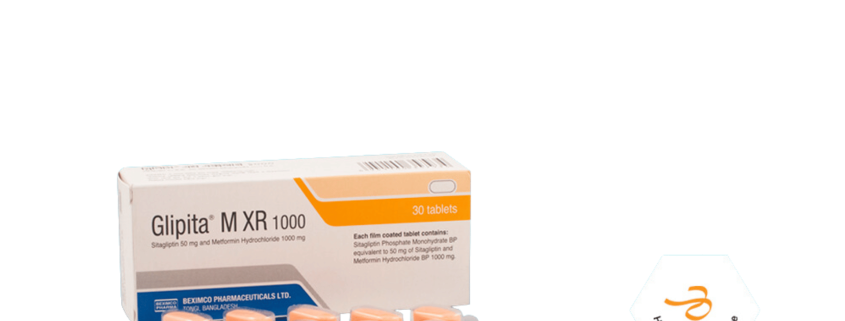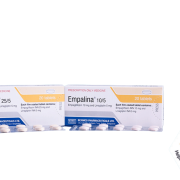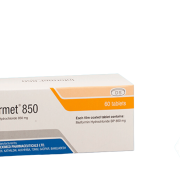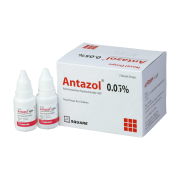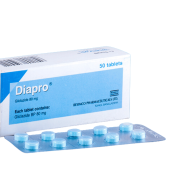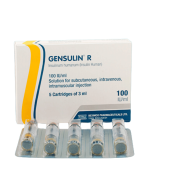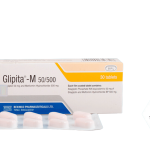Glipita M XR
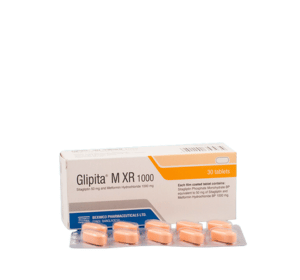
Generic Name: Sitagliptin & Metformin Hydrochloride
Dosage Form: Tablet
TG Name: Endocrine & Diabetes
1. What is Glipita® M XR?
Glipita® M XR tablets contain two oral antihyperglycemic drugs used in the management of type 2 diabetes: Sitagliptin and Metformin Hydrochloride.
2. How Glipita® M XR works in our body?
Sitagliptin Phosphate is an orally-active, potent, and highly selective inhibitor of the dipeptidyl peptidase-4 (DPP-4). The DPP-4 inhibitors are a class of agents that act as incretin enhancers. By inhibiting the DPP-4 enzyme, Sitagliptin increases the levels of two known active incretin hormones, glucagon-like peptide-1 (GLP-1) and glucose-dependent insulinotropic polypeptide (GIP).
The incretins are part of an endogenous system involved in the physiologic regulation of glucose homeostasis. When blood glucose concentrations are normal or elevated, GLP-1 and GIP increase insulin synthesis and release from pancreatic beta cells. GLP-1 also lowers glucagon secretion from pancreatic alpha cells, leading to reduced hepatic glucose production. By increasing and prolonging active incretin levels, Sitagliptin increases insulin release and decreases glucagon levels in the circulation in a glucose-dependent manner.
Metformin is an antihyperglycemic agent which improves glucose tolerance in patients with type 2 diabetes, lowering both basal and postprandial plasma glucose. Its pharmacologic mechanisms of action are different from other classes of oral antihyperglycemic agents. Metformin decreases hepatic glucose production, decreases intestinal absorption of glucose, and improves insulin sensitivity by increasing peripheral glucose uptake and utilization. Unlike sulfonylureas, Metformin does not produce hypoglycemia in either patients with type 2 diabetes or normal subjects and does not cause hyperinsulinemia. With Metformin therapy, insulin secretion remains unchanged while fasting insulin levels and day-long plasma insulin response may actually decrease.
3. What is the indication of Glipita® M XR?
Glipita® M XR is indicated as an adjunct to diet and exercise to improve glycemic control in adults with type 2 diabetes mellitus when treatment with both Sitagliptin and Metformin is appropriate.
4. What are the dosage & administration of Glipita® M XR?
The dosage of Glipita® M XR should be individualized on the basis of the patient’s current regimen, effectiveness, and tolerability while not exceeding the maximum recommended daily dose of 100 mg Sitagliptin and 2000 mg Metformin.
Glipita® M XR should generally be given once daily with meals, with gradual dose escalation. The starting dose of Glipita® M XR should be based on the patient’s current regimen.
The recommended starting dose in patients not currently treated with Metformin is 100 mg Sitagliptin/1000 mg Metformin Hydrochloride once daily, with gradual dose escalation recommended to reduce gastrointestinal side effects associated with Metformin.
The starting dose in patients already treated with Metformin should provide Sitagliptin dosed as 100 mg total daily dose and the dose of Metformin already being taken. For patients taking Metformin 850 mg twice daily, the recommended starting dose of Glipita® M XR is two tablets of 50 mg Sitagliptin/1000 mg Metformin hydrochloride once daily.
Patients treated with an insulin secretagogue or insulin: Co-administration of Glipita® M XR with an insulin secretagogue (e.g., sulfonylurea) or insulin may require lower doses of the insulin secretagogue or insulin to reduce the risk of hypoglycemia.
No studies have been performed specifically examining the safety and efficacy of Glipita® M XR in patients previously treated with other oral antihyperglycemic agents and switched to Glipita® M XR. Any change in therapy of type 2 diabetes should be undertaken with care and appropriate monitoring as changes in glycemic control can occur.
5. What are the contraindications of Glipita® M XR?
Glipita® M XR is contraindicated in patients with: Renal disease or renal dysfunction, e.g., as suggested by serum creatinine levels ≥1.5 mg/dL [males], ≥1.4 mg/dL [females] or abnormal creatinine clearance which may also result from conditions such as cardiovascular collapse (shock), acute myocardial infarction, and septicemia; acute or chronic metabolic acidosis, including diabetic ketoacidosis, with or without coma; history of a serious hypersensitivity reaction to Glipita® M XR or Sitagliptin (one of the components of Glipita® M XR), such as anaphylaxis or angioedema. Glipita® M XR should be temporarily discontinued in patients undergoing radiologic studies involving intravascular administration of iodinated contrast materials, because use of such products may result in acute alteration of renal function.
6. What are the adverse effects of Glipita® M XR?
The most common side effects of Glipita® M XR include:
- stuffy or runny nose and sore throat.
- upper respiratory infection.
- low blood sugar (hypoglycemia) when used in combination with certain medications, such as a sulfonylurea or insulin.
- gas, upset stomach, indigestion.
- weakness.
- nausea and vomiting.
- headache.
- diarrhea.
7. What would be the storage condition of Glipita® M XR?
Store at a cool & dry place, away from light. Keep out of reach of children.

